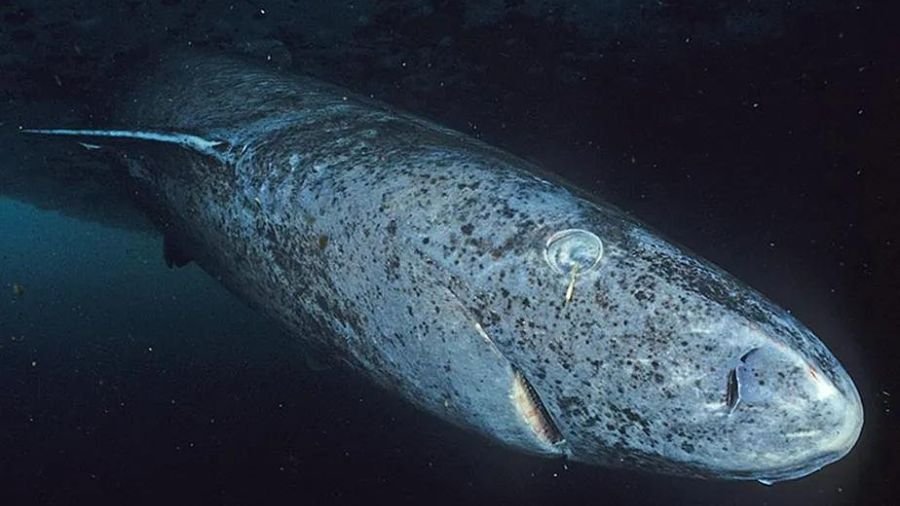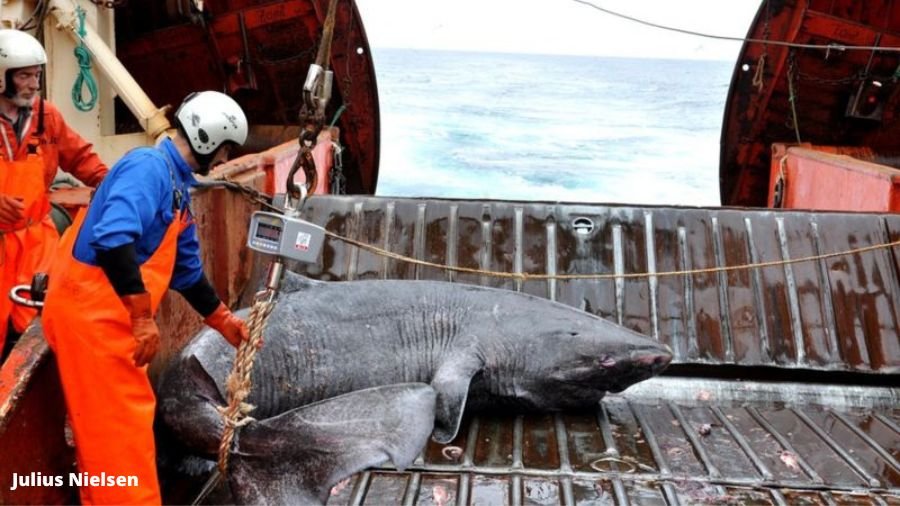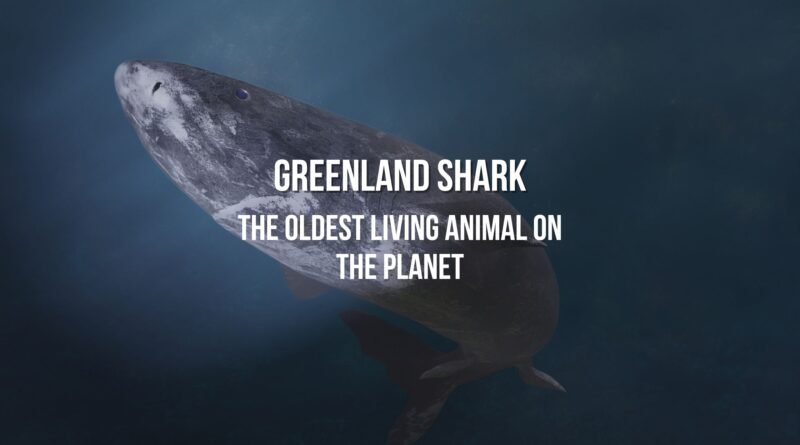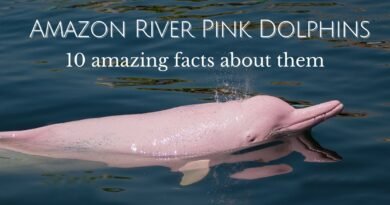Greenland shark: the oldest living animal on the planet
It seems crazy to imagine that an animal alive in our days was already around when the United States Declaration of Independence was adopted, in 1776, isn’t it? Or during the French Revolution, which began in 1789. But that is possible, and the oldest living animal on the planet is the Greenland shark, the oldest living vertebrate in the world. In this article, we will learn a little about this magnificent animal, its features, and the dangers it faces. Let’s go then! Enjoy reading!
Greenland shark: what is known about it?
There are about 500 species of sharks currently known and the Greenland shark is one of the least studied. One of the reasons so little is known about this animal is its habitat: the icy, deep waters of the Arctic Ocean. Although it is known that it is also found in other places, it is the only representative of the shark species that is found throughout the year in the Arctic, even in the coldest months. Other species of shark migrate during the coldest season, except this one. Despite this, it can also be seen in the North Atlantic and the Russian Arctic. Always in extremely cold waters, with below-zero temperatures, and at abysmal depths, more than 6,560 feet underwater. For these reasons, it is so little studied.

Physical features
Also known as the ground shark, the Greenland shark is one of the largest known sharks, reaching up to 19 feet in length. Although there are reports of individuals measuring almost 23 feet in length. As a basis for comparison, the fierce predatory great white shark can measure from 13 to almost 20 feet. The difference between both is that the great white shark is much heavier at over 2 tons, while the Greenland shark weighs no more than 1.5 tons.
Greenland sharks have cylindrical bodies, flattened and broad heads. They are usually dark in color, between dark gray, brown, or black, which gives them great advantage for camouflage in the deep waters in which they inhabit. Its snout is white and scientists believe it’s due to “repeated abrasion”: the shark scratches its snout when searching for food on the ocean floor. They don’t have anal fins and their powerful dentition is made up of large square teeth on the lower jaw and sharper teeth on the upper part.
Over the years, the Greenland shark ends up going blind due to a parasite that settles in its eyes. The Ommatokoita Elongata is a tiny crustacean, which attaches itself to the cornea and damages it, causing an infection. After the infection heals, there is scar tissue over the eye, and with each new infection, new tissue forms, and this, over time, completely takes away the shark’s vision. However, its survival is not affected, as it uses other heightened senses.
Adaptation to the cold
The Greenland shark is highly adapted to survive in freezing temperatures and belongs to a group known as sleeper sharks. As the name of the group suggests, the sharks of this group are incredibly slow-behaving animals, which is vital for their survival in icy waters, as it saves energy. The Greenland shark moves at a slow 1.12 feet per second, and this “speed” guarantees it the title of slowest shark on the planet.
Another impressive adaptation of the Greenland shark for living in these polar waters are the chemicals in its skin. High concentrations of trimethylamine N-oxide (TMAO) and urea work like antifreeze and prevent the formation of ice crystals, stabilizing the body’s proteins and keeping them alive and active (if slowly) in extreme cold.
With so many chemicals in its body, Greenland shark meat is toxic to humans, however, in Iceland, it is used in a typical dish of local cuisine known as Hákarl. To make this dish, you have to let the meat rot, enter a fermentation process, leave it to dry for months and only then is it cut into cubes and served. No, thanks! 😊

Behavior and reproduction
When they are in a hurry, they can reach a speed of 1.86 miles per hour! Yes, that’s right, we’re not kidding! And exactly because of this speed or lack of it, their food is based almost entirely on the carrion of dead animals they find at the bottom of the sea. However, there is evidence that they are ambush hunters, and also feed on fish, squid, and even the speedy seals. Some studies show dissected individuals that carried the remains of horses, reindeer, and other large land mammals in their stomachs. It is not known if they were eaten still alive or dead, after falling into the water. However, what is known is that these large and long-lived fish, the oldest living animal on the ocean, can rise to the surface (even if they do so very rarely), at the edge of the ice, to feed.
They are solitary animals and seek company only during the mating period. Shy, they are not aggressive and do not pose a danger of attack to humans. All this timidity, its slow speed, and its preference for the depths of the polar waters made it very difficult to obtain images of this animal. Only in 1995 it was possible to take a photograph, the first in history, of a live Greenland shark, according to National Geographic.
The Greenland shark, the oldest living animal on the planet, not only moves slowly but especially lives slowly. A study by the Florida Museum of Natural History brings the report of a Greenland shark identified in 1936 that, after 16 years, had grown only 2.36 inches! To reach sexual maturity and reproduce, the Greenland shark takes 150 years! They are ovoviviparous and produce an average of 10 pups in each pregnancy.

The oldest living animal on the planet
A marine biologist at the University of Copenhagen, Julius Nielsen, and lead author of research on the longevity of Greenland sharks in the scientific journal Science, explains how they concluded that these fish are the oldest vertebrates in the world. Before this research, it was believed that it was the bowhead whale (Balaena mysticetus) that held this title, with an approximate age of 200 years.
The research included 28 Greenland sharks being studied and with the use of carbon dating, it was possible to determine the age of these animals. A female that had been found dead (probably after being caught in fishing nets) was studied and her age was estimated at 400 years! Can you imagine that? She was born in the 17th century!
The researchers also discovered that these sharks grow extremely slowly, at just 0.39 inches per year.
The part of the animal used for carbon dating studies is its retina. As Nielsen explained, “The Greenland shark’s retina is made of a specialized material – and it contains metabolically inert proteins. This means that once the proteins are synthesized in the body, they are not renewed again. So we can isolate that tissue formed when the shark was a baby, and do the radiocarbon dating.”
Fun fact: In the eastern North Atlantic, Greenland sharks can be observed far inland in deep fjords. Due to these sightings, there is speculation that it was these sharks that contributed to the Loch Ness Monster myth. (Source: Oceana.org)

Conservation status
According to the IUCN ( The International Union for Conservation of Nature), the Greenland shark is considered a “vulnerable” species. And it’s no wonder, imagine an animal that takes 150 years to start reproducing! Its conservation status is no longer critical because its meat is toxic for human consumption. But climate change and the high number of dead animals trapped in commercial fishing nets threaten survival of the oldest living animal on the planet.
Conclusion
The Greenland shark is truly a fascinating and remarkable animal. Living for centuries, facing the dangers that humans pose and its adaptations to survive in the extreme conditions of freezing Arctic waters makes it, with no doubt, one of the most spectacular representatives of marine fauna and worthy of studies and preservation actions. These lords of the seas show us how imposing they are and how impressive nature is!
We hope you enjoyed knowing a little about this magnificent species of shark, the oldest living animal on the planet, and we look forward to seeing you in the next articles.
Until next time! ♥




